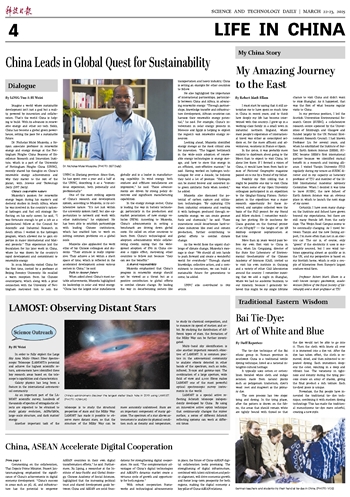
I must start by saying that it still astonishes me to have spent so much time in China in recent years, and to think how deeply my life has become intertwined with this country...I grew up in a working-class family in a small town in industrial northern England, where most people's experience of international travel was either as conscripted soldiers or, for the more affluent and adventurous, vacations in France or Spain.
In the 1960s, it was probably more realistic to daydream about going to the Moon than to expect to visit China, let alone live there. If I formed a vision of China, it would have been from back issues of National Geographic magazine passed on to me by a friend of my father.
Possibly my first inkling that it might be possible one day to visit China was when some of my Open University colleagues participated in an expedition to the Qinghai-Xizang Plateau. Participation in the expedition was a major research opportunity for those involved, and samples collected were the basis of the PhD project for my friend and fellow student. I remember watching her plotting Rb-Sr isochrons for Lhasa granites on the thermal printer of an HP4585T — the height of 192 kB desktop computer sophistication at that time.
More than 25 years would pass before my own first visit to China in 2011, when Liu Congqiang, director of the State Key Laboratory of Environmental Geochemistry of the Chinese Academy of Sciences (CAS), invited us to visit his own institute in Guiyang and a variety of other CAS laboratories around the country. I remember insisting that we add a night in Shanghai, where we had no academic business, to our itinerary, because I genuinely believed this might be my single lifetime chance to visit China and didn't want to miss Shanghai. As it happened, that was the first of what became regular visits to China.
In my previous position, I led the Scottish Universities Environmental Research Centre (SUERC), a collaborative research centre operated by the Universities of Edinburgh and Glasgow and funded largely by the UK Natural Environment Research Council. I had known Professor Liu for several years, and when he established the Institute of Surface Earth System Science (ISESS), SUERC became ISESS's first international partner because we identified mutual benefit in a research and training alliance. I visited Tianjin University (TJU) regularly during my tenure as SUERC director and in my capacity as honorary professor of TJU and member of the ISESS International Academic Advisory Committee. When I decided it was time to leave SUERC, the new School of Earth System Science was an obvious place in which to launch the next stage of my career.
Certainly, I have seen many changes; the Institute and School have grown beyond my expectations, but there are still many friends left from the early days. The Weijin Road Campus seems to be continually changing. As I travel between Tianjin and the new Daxing airport, I'm more often than not in an electric car. The car is, of course, only "green" if the electricity it uses is sustainably sourced, but I see wind turbines appearing almost as quickly as in the UK, and my perspective is based on my Scottish home, which is only a couple of kilometres from Europe's largest onshore wind farm.
Professor Robert Mark Ellam is a well-known isotopic geochemist, academician (Fellow of the Royal Society of Edinburgh) and a chair professor at TJU.







